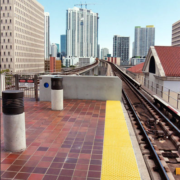Detectable Warning Surfaces Keep Schools, Airports, and Mass Transit Environments Safe
ADA Solutions’ truncated domes are a type of detectable warning solution used in schools, airports, and mass transit environments. This special raised surface has small raised round sections, which non-visually impaired people and children sometimes say look like Lego® blocks that have been “snapped” into the ground.
What purpose do warning surface truncated domes serve?
The primary purpose is to provide a non-visual cue to those with visual impairments of a pending safety or hazard concern. For instance, the raised “bubble-like” bumps on the truncated domes are easy to detect with a cane so blind people can feel the changes on the surface. This lets them know they are approaching a busy intersection, drop-off, or another change in the pavement.
Why are warning surface truncated domes required?
Long before warning surface truncated domes become mandatory by government regulations, there were other regulations enacted for wheelchair-bound individuals. These regulations required curbs, short stairways, and other such areas with difficult limited access to provide special access for easier accommodations.
The use of ramps become quite common for entering buildings or crossing streets. Ramps could also be used in transport stations for easier boarding of buses, trains, and subway cars. However, as a result of the changes that came about in the Rehabilitation Act of 1973 and the Americans with Disability Act (ADA) of 1990, those with visual impairments found it more difficult to navigate safely.
It had become more difficult for them to tell the difference between the sidewalk and the edge of a busy street. They also had issues when boarding buses, trains, and subway cars because they could not distinguish between boarding waiting areas and pickup/drop off zones, or found themselves falling onto subway rails or walking onto rail tracks. Due to these safety risks, warning surface truncated domes became required with various updates to the ADA in 1991, 2001, and again in 2016.

How do warning surface truncated domes help improve safety?
Warning surface truncated domes are the only type of surface that is easily detectable by those with visual impairments, thanks to its unique design. Whether they use a cane to feel their way along while walking or use their feet, it is easier for people with reduced or no vision to realize they are walking on a truncated dome and that there is about to be a change on the other side, such as:
- Entering a busy intersection
- Changes to elevations like inclines and declines on a ramp
- Drop-offs like at the edge of a railway loading platform.
Even people without visual impairments benefit from warning surface truncated domes. For instance, people devote much attention to their smartphones when walking and do not pay attention to their surroundings—yet they know to look up when they walk onto a truncated dome surface.
As you can see, truncated domes provide an easily detectable warning surface to help keep people safe in public areas, as well as government and commercial buildings. To learn more about various tactile warning surface solutions and products for your building or outdoor areas, please feel free to contact ADA Solutions at (800) 372-0519 today!








